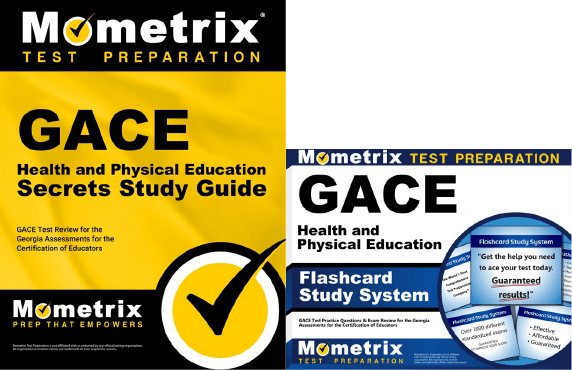If you need help studying for the GACE Health and Physical Education test or just want some more information about what the test is like, you’ve come to the right place!
Click below to take a free GACE Health and Physical Education practice test!
What’s on the Test?
The GACE Health and Physical Education test contains 200 multiple-choice questions and is timed at 4 hours and 20 minutes.
The exam is split into two subtests, which are taken in separate testing sessions (but can be taken on the same day if you’d like).
SUBTEST I (115)
100 questions | 2 hours and 10 minutes
Mental and Emotional Health/Professional Issues (25%)
- Understanding psychosocial development/emotional well-being
- Knowing the causes/consequences of mental/emotional health issues
- Understanding stress management skills
- Knowing how to identify factors that promote positive self-concept and self-esteem
- Understanding factors affecting healthy and unhealthy relationships
- Understanding the concepts of interpersonal communication
- Knowing the consequences of risk-taking behaviors
- Knowing the signs, symptoms, causes, and effects of self-destructive behavior
- Understanding the causes of conflict among youth
- Understanding goal-setting and decision-making
- Knowing how to locate and use valid sources of health information
- Understanding risk factors and protective factors related to personal health and safety practices
Personal Health and Wellness, Sexual Health, and Nutrition (40%)
- Knowing the concepts of personal hygiene
- Understanding the concepts of anatomy and physiology and body system interrelationships
- Knowing the patterns and stages of physical, cognitive, social, and emotional growth and development
- Understanding various factors that affect physical, cognitive, social, and emotional growth and development
- Knowing how to describe disease etiology and prevention/treatment
- Understanding the difference between communicable and non-communicable diseases
- Understanding the role of the body’s immune system
- Knowing the anatomy/physiology of the human reproductive system
- Knowing the methods for preventing pregnancy, STDs, and HIV/AIDS
- Knowing the functions and sources of nutrients
- Understanding the components of My Plate and Dietary Guidelines for Americans
- Understanding factors affecting food choices and eating habits
Safety and Injury Prevention, and Alcohol, Tobacco, and Other Drugs (35%)
- Understanding weather emergencies
- Knowing methods for promoting self-care, safe behaviors, and injury prevention
- Knowing appropriate ways to respond to accidents
- Understanding threats to personal safety
- Knowing the legislation, agencies, and policies that support community health
- Understanding the causes, consequences, and prevention of different types of abuse and violence
- Understanding the effects of substance use and abuse
- Knowing the appropriate uses of medicines
- Knowing the classifications of alcohol, tobacco, and other drugs
- Understanding the factors contributing to health risks associated with the use of alcohol, tobacco, and other drugs
- Understanding how adolescent and teen drug use contributes to accidents, crime, suicide, mortality, and sexual activity
- Understanding that alcohol, tobacco, and drug dependencies are treatable diseases
SUBTEST II (116)
100 questions | 2 hours and 10 minutes
Basic Sciences of Physical Education (20%)
- Understanding biomechanics and kinesiology
- Understanding exercise physiology and fitness
- Knowing the major muscle groups
- Understanding components of flexibility
Motor Learning and Motor Development (15%)
- Knowing instructional prompts and cues for providing motor performance feedback
- Understanding principles, stages, sequences, and characteristics of motor development and learning
- Understanding skill themes and ways to promote movement concepts
- Understanding motor-learning concepts
- Understanding factors influencing motor development and learning
- Knowing how to apply movement concepts
- Knowing how to select developmentally appropriate techniques, equipment, and materials for complex activities
- Knowing critical elements of movement patterns
- Understanding movement principles and their application
Sports, Activities, and Fitness (30%)
- Understanding critical elements essential to competent performance in creative movement and dance
- Knowing the skills and performance assessment techniques for individual, dual, team, and lifetime activities
- Knowing principles and techniques for designing a fitness plan
- Knowing the appropriate etiquette, interactions, environmental considerations, and care of equipment
- Understanding critical elements of outdoor, adventure, and cooperative activities
- Knowing the effect of participation in sports and activities
Instructional Principles and Professionalism in Physical Education (35%)
- Knowing the principles of classroom management
- Understanding the psychological and social factors that affect individual and group learning
- Knowing how to manage resources
- Knowing how to motivate students
- Knowing how to promote positive relationships
- Knowing how to use rules and routines to create a safe and effective learning environment
- Understanding effective verbal and nonverbal communication
- Knowing how to provide appropriate instructional feedback
- Knowing how to promote opportunities to be physically active
- Knowing how to achieve and maintain a health-enhancing level of fitness in a physical education program
- Knowing how to design and sequence activities for skill development
- Understanding the factors affecting participation in physical activity
How to Register
To get started with the registration process, you’ll need to create a MyPSC account on the GaPSC website. You should receive a Georgia Certification ID (GA CERT ID) during this process, which you’ll use for identification throughout the registration and testing process.
The next step is to create an ETS GACE testing account on the ETS website. This account will allow you to register for the exam and pay the testing fee(s). If you take each subtest separately, the fee is $123 for each subtest. If you take both subtests together, the fee is $193.
How the Exam is Scored
The GACE Health and Physical Education test is scored using a scaled scoring method. Here’s how it works:
For every question you answer correctly, you get one point added to your raw score. At the end of the test, your final raw score will be converted to a scaled score. You’ll need a scaled score of at least 220 on the multiple-choice questions to pass the exam.
The reason your raw score is converted to a scaled score is because everyone that takes the test is given a slightly different set of questions. Since everyone has a different arrangement of questions, and because some questions are harder than others, converting your raw score to a scaled score ensures a more even playing field.
Passing Scores
There are two passing levels for this exam: induction and professional. Each level has its own minimum passing score requirements:
- Induction Level: 220-249
- Professional Level: 250
Here’s something to keep in mind: You have to pass at the professional level on BOTH subtests in order for your final exam scores to count at the professional level. If you only pass at the induction level on one of the subtests, your final exam score will only count at the induction level.
Retaking the Exam
If you don’t get the score you want on your first try, that’s okay! You can take the exam again after a mandatory 30-day waiting period.
FAQs
How many questions are on the GACE Health and Physical Education exam?
The exam contains 200 questions.
What is the time limit for the GACE Health and Physical Education exam?
The exam is timed at 4 hours and 20 minutes.
What is the passing score for the GACE Health and Physical Education exam?
You’ll need to get a final score of at least 220 to pass the exam.
How much does the GACE Health and Physical Education exam cost?
The exam fee is $193 for the full exam.



 GACE Study Guide
GACE Study Guide GACE Flashcards
GACE Flashcards